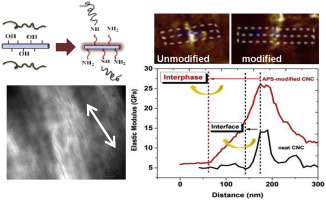Polymer ( IF 4.6 ) Pub Date : 2017-09-01 , DOI: 10.1016/j.polymer.2017.08.064 Shahab Kashani Rahimi , Joshua U. Otaigbe

|
Polyamide 6 (PA6) nanocomposites containing cellulose nanocrystals (CNCs) were prepared via a multi-step process consisting of in-situ anionic ring-opening polymerization and subsequent melt extrusion. The effect of surface modification of the CNCs with aminopropyl triethoxysilane (APS) was studied in detail using microscopic, mechanical and rheological techniques and compared with that of the neat CNC nanocomposites. Solid-state 29Si NMR analysis was used to confirm the interfacial bond formation between the PA6 matrix and surface modified CNCs. SEM images showed that upon surface modification, the morphology of CNCs within the matrix transformed from a fibrillar structure towards more individually dispersed nanocrystals with enhanced dispersion and higher interfacial area. The matrix-particle interphase was further investigated using quantitative nanomechanical mapping (QNM) to study the role of interfacial modification on thickness of interphase and development of a broader modulus gradient across the interface. The quality of dispersion and development of the rigid interfacial layer in the modified system resulted in significant improvement in solid-state mechanical properties of the nanocomposites. In addition, melt rheological studies showed significant improvements of melt elasticity and strength in shear and elongational flow in the nanocomposites systems.
中文翻译:

界面对原位开环聚合反应及随后熔体挤出制备的聚酰胺6 /纤维素纳米晶体纳米复合材料的微观结构和流变力学性能的影响
包含纤维素纳米晶体(CNC)的聚酰胺6(PA6)纳米复合材料是通过多步工艺制备的,该工艺包括原位阴离子开环聚合反应和随后的熔融挤出。使用微观,机械和流变技术详细研究了氨基丙基三乙氧基硅烷(APS)对CNCs进行表面改性的效果,并将其与纯净的CNC纳米复合材料进行了比较。固态29Si NMR分析用于确认PA6基质与表面改性CNC之间的界面键形成。SEM图像表明,在表面改性后,基质中CNC的形态从原纤维结构向分散性更高和界面面积更大的纳米晶体转变为更分散的纳米晶体。使用定量纳米机械映射(QNM)进一步研究了基质-颗粒间相,以研究界面改性对相间厚度和跨界面形成更宽的模量梯度的作用。改性体系中刚性界面层的分散质量和发展导致纳米复合材料的固态机械性能得到显着改善。此外,


























 京公网安备 11010802027423号
京公网安备 11010802027423号